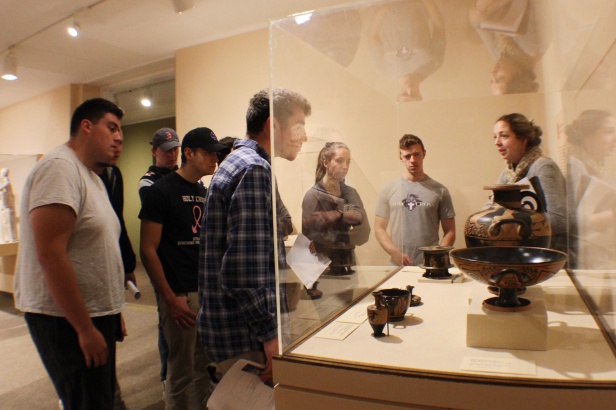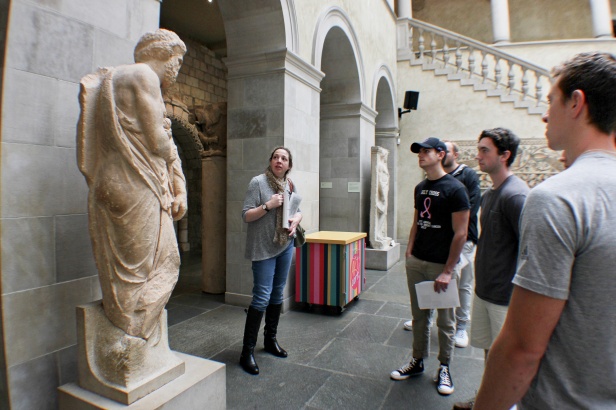By Hui Li, ’21
Chief Photographer
On Friday, Sept. 28, and over the weekend, students in Professor Amanda Reiterman’s Classical Archaeology class got to enjoy a more direct approach to their course material: they explored 2,500 years of ancient art at the Worcester Art Museum. After learning about Classical artifacts through two-dimensional images in the classroom, the students were in for a treat when they went off campus to look at authentic three-dimensional objects on display.
Professor Reiterman of the Holy Cross Classics Department, who specializes in Mediterranean archaeology, started her lesson in the museum’s Greek wing, which houses objects from the ancient Mediterranean dating from the Bronze Age to the 3rd Century B.C.E. The oldest artifact in the collection is a female figurine carved in the Cycladic islands southeast of mainland Greece before 2000 B.C.E. The exhibit also features a large variety of ancient pottery from different eras and locations. The Corinthian vases in the exhibit date to around 800 B.C.E. while the Athenian pieces are from the 4th and 3rd Centuries B.C.E.
The vases in the collection are of different shapes and sizes to suit specific purposes in the past, with the larger clay jugs meant to hold and mix liquids and the smaller vessels designed to hold perfume and cosmetics. The Corinthian pottery is decorated with colorful geometric patterns while the Athenian artifacts are orange and black, with images of people, animals, and mythological scenes painted on them. The Classical Archaeology class examined the iconography of the Athenian pottery, noting how the imagery provides insights into the daily life and culture in the ancient world. In particular, the vases shed light on the lives of women, whose routines and activities are less commonly recorded in writing.
Beside the vases was the head of a large limestone statue from 6th-5th Century Cyprus. The head is that of a female figure thought to be Aphrodite, the Greek goddess of love. The proportions of the statue’s face resemble stylistic traits associated with lands in the eastern Mediterranean, and the smaller figures on the statue’s crown are of non-Greek deities. Students discussed the foreign influences on art in the ancient world, and the statue is an example of syncretism, a mixing of different cultures. From artifacts such as the statue head in the Greek Wing, it is clear that trade in the ancient Mediterranean brought not only new commodities, but also different beliefs and cultures, to the ancient Greek world.
After a tour of the Greek Wing, Professor Reiterman brought her students upstairs to the Jeppson Idea Lab, where she helped curate a specialized exhibit on ancient Greek pottery. She showed them the three pieces of pottery on display while videos showing conservationists working on the pieces played nearby. Here, students learned about the iconography on the three vases and how archaeologists and museum conservationists work to reconstruct artifacts in the 21st century.
On the way to the Roman exhibit, the group stopped by the Renaissance Court and looked at the eye-catching “Worcester Hunt” mosaic laid out on the floor. The massive mosaic was excavated from Antioch, in modern-day Syria, and depicts a hunt in the Greco-Roman style. The piece, which is the largest Antioch Mosaic in the United States, is an icon at the Worcester Art Museum. Alongside the famous centerpiece were other Classical mosaics displayed on the walls around the Court.
Just outside the Roman exhibit, Professor Reiterman and her students stopped by the two ancient Greek sculptures standing near the doorways. They compared and contrasted the two pieces. Both were from grave monuments depicting men in different styles from two time periods. One sculpture has the proportions of an “idealized man” with a stoic expression on his face. These were tropes common in the 5th-4th Centuries B.C.E. The other sculpture resembles an older man with a more accurate physique and realistic somber expression on his face, indicating roots from the later Hellenistic period, beginning around the 3rd Century B.C.E.
The tropes of idealized figures and increased realism continued in the Roman exhibit, where the chiseled marble busts of emperors and other important figures were displayed next to realistic portraits and sculptures of everyday people from the Roman Empire. Just as they did in the Greek Wing, the students noted how some of the later Roman artifacts dating as late as 300 C.E. had influences from other cultures. In particular, the Fayum portraits in the exhibit came from Roman Egypt, where people kept the funerary custom of mummification and added another custom of placing painted portraits with the faces of the deceased and inscriptions about their names and occupation before burial.
In the weeks before the Classical Archaeology students went to the Worcester Art Museum, they learned not only about artifacts by themselves, but also about what they can tell modern viewers about the past. Through looking closely at ancient objects, we can learn about the lives of not only the most rich and famous, but also of everyday people and the multifaceted and syncretic cultures around them.
Admission to the Worcester Art Museum is free with a Holy Cross ID. The Museum is also open until 8:00 p.m. and hosts special events on the third Thursday of every month.

Professor Reiterman and her Classical Archaeology class take a closer look at Athenian pottery in the Greek Wing, courtesy of Hui Li

The group looking at ancient Greek sculptures alongside the famed mosaics in the Renaissance Court, courtesy of Hui Li

Brava! I look forward to a great semester here at Temple Rome.
LikeLike